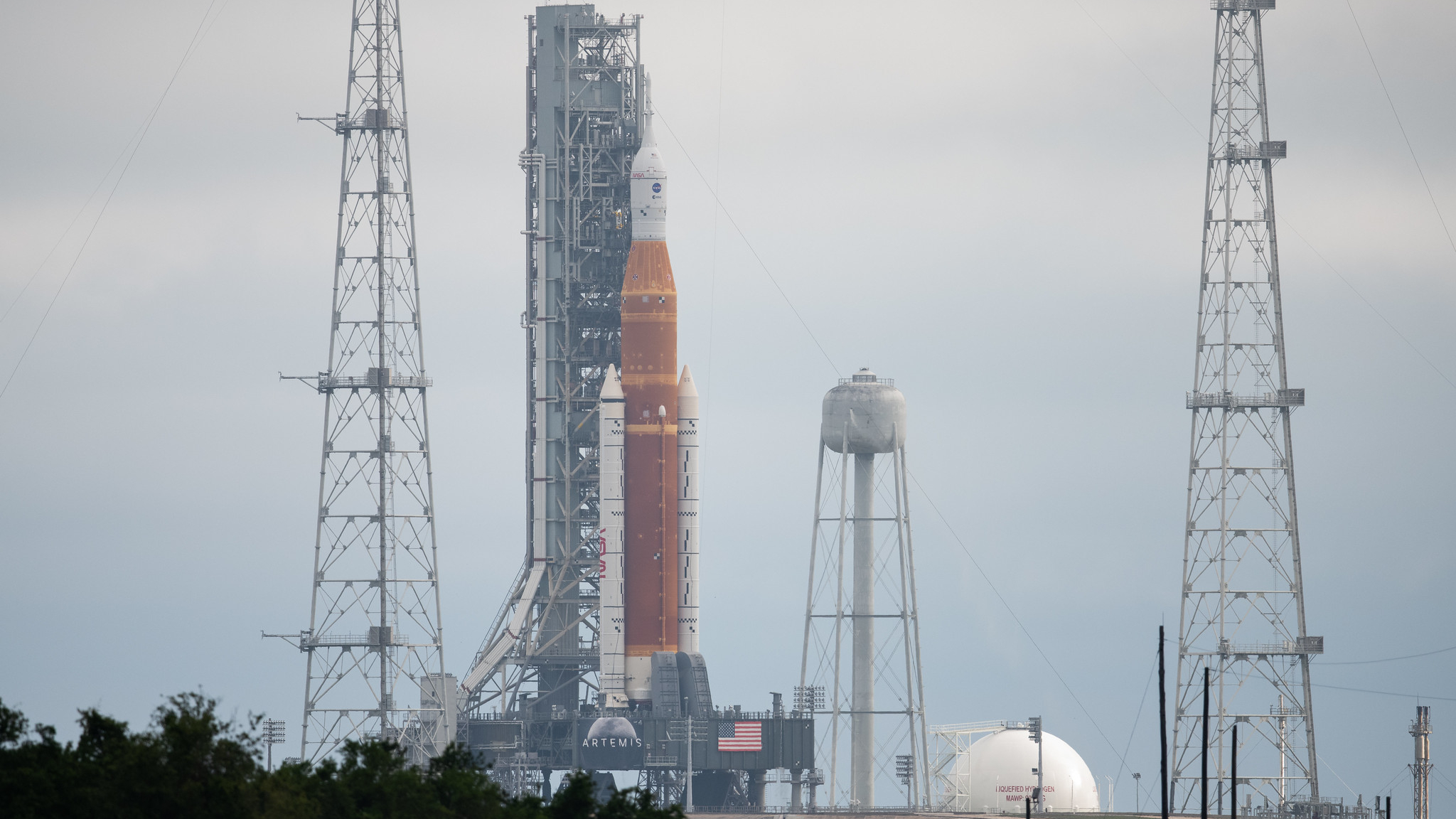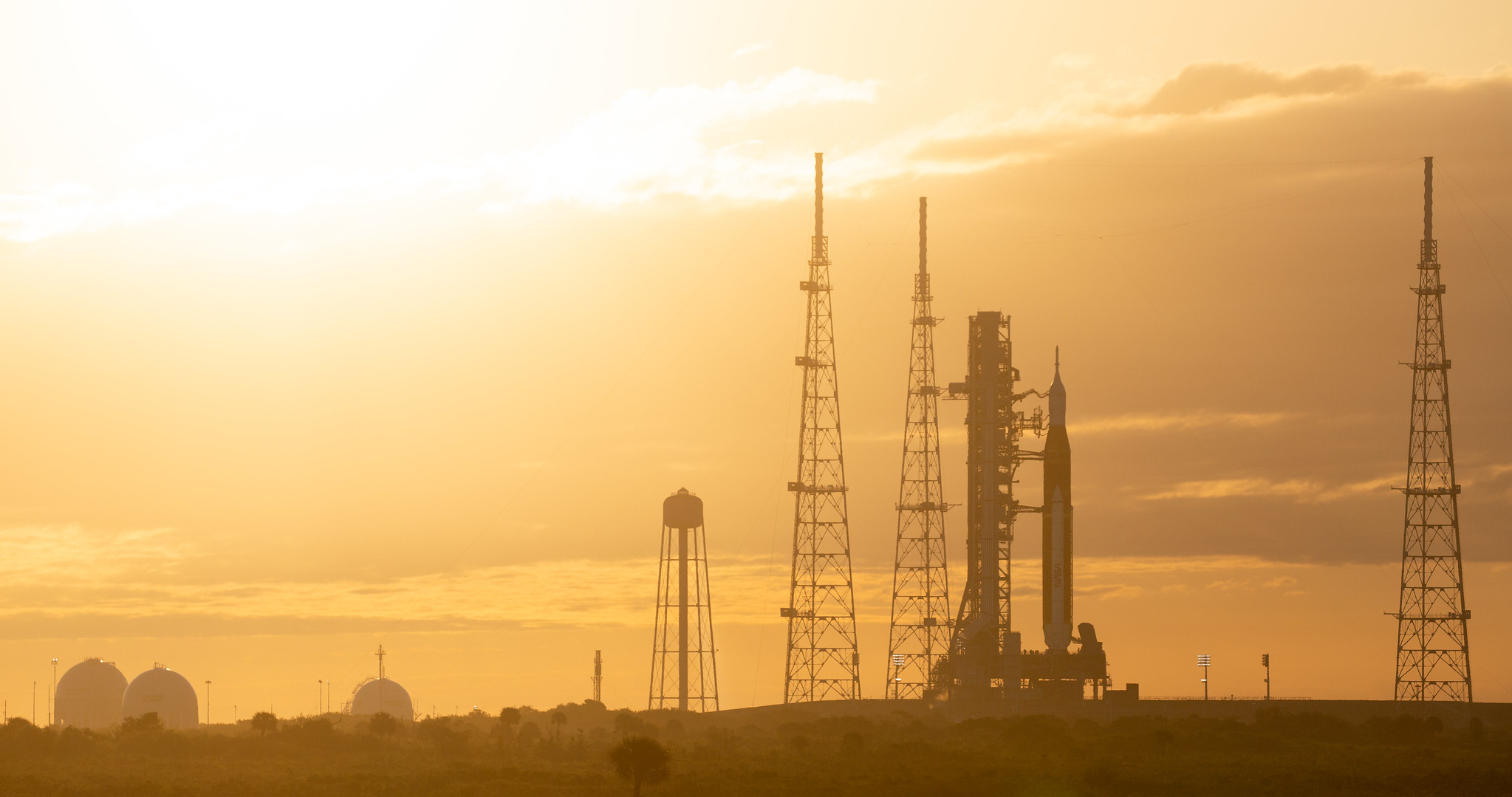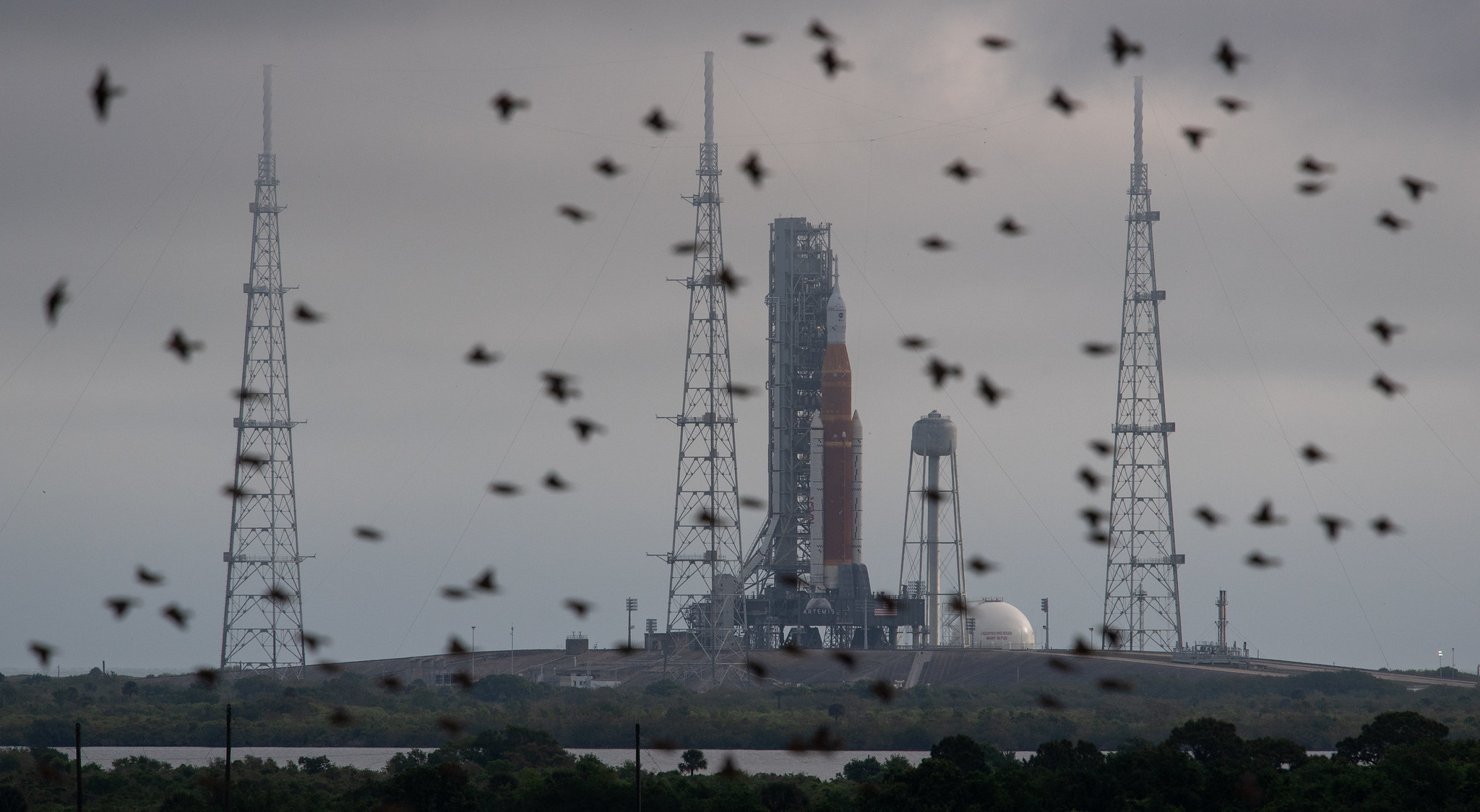NASA calls off critical Artemis 1 moon rocket test over safety concerns
The agency will try again on Monday (April 4).

NASA called off a critical fueling test of its Artemis 1 moon rocket on Sunday due to safety concerns with ground equipment on the booster's mobile launcher platform.
Technicians planned to fuel the Artemis 1 megarocket, called the Space Launch System (SLS), with 700,000 gallons (2.6 million liters) of super-cold propellant on Sunday (April 3) at Pad 39B of NASA's Kennedy Space Center in Florida. The fueling test was the final stage of a three-day "wet dress rehearsal" designed to test launch countdown process for NASA's Artemis 1 mission to the moon later this year.
But a problem on the Artemis 1 rocket's mobile launcher, a platform that includes its gantry tower and other vital equipment, foiled the test, NASA officials said. A system that uses fans to pressurize the mobile launcher and keep out harmful gases failed.
NASA will attempt to finish the wet dress rehearsal on Monday (April 4), with loading of fuel expected to begin around 7 a.m. EDT (1100 GMT), agency officials confirmed during a news conference held Sunday evening.
Live updates: NASA's Artemis 1 moon mission
Related: NASA's Artemis 1 moon mission explained in photos
The Artemis 1 rocket has had a busy few days during the wet dress rehearsal, which began Friday evening (April 1).
"The last 48 hours has been one of the more interesting 48 hours that I've had in the context of working missions leading up to a launch," Mike Sarafin, Artemis mission manager for NASA, said during the news conference.
Get the Space.com Newsletter
Breaking space news, the latest updates on rocket launches, skywatching events and more!
Saturday was a particularly stormy day in Cape Canaveral, where KSC is located; weather officials for the procedure predicted a 90% chance of precipitation and an 80% chance of lightning, both of which materialized.
"We knew that weather was going to be probably one of our bigger challenges," Sarafin said. And indeed, by early afternoon on Saturday, four lightning strikes were detected at Pad 39B, one of them particularly strong, but none of them struck the SLS rocket, NASA reported. They were diverted by the pad's lightning protection system, which is made up of three tall towers and a network of catenary lines that redirect electrical current to the ground away from the rocket.
Responding to the lightning strikes set the team back about four hours, Charlie Blackwell-Thompson, the Artemis 1 launch director, said during the news conference. Overnight, the teams made up most of that time, and officials decided to proceed with the wet dress rehearsal on Sunday.
"We kinda knew that we were proceeding at risk relative to the timeline, but we had great weather today and we had the range available so we decided to proceed," Sarafin said.

But shortly after 7 a.m. EDT (1100 GMT), Blackwell-Thompson said, the team was alerted to an issue with a fan that pressurizes the mobile launcher. That issue turned out to be a breaker trip, and personnel switched to the fan's redundant back-up — only to have that fan also stop working. As of 5:30 p.m. local time (2130 GMT), teams were inspecting the fan system, Blackwell-Thompson said, and she expected to have their results in hand within an hour or two.
"The fans are needed to provide positive pressure to the enclosed areas within the mobile launcher and keep out hazardous gases," NASA wrote in an update Sunday. "Technicians are unable to safely proceed with loading the propellants into the rocket's core stage and interim cryogenic propulsion stage without this capability."
Currently, personnel do not believe that the fan issue is related to the lightning strikes, since the fan continued to operate into Sunday morning before the failure. Besides the fan system, all seems well, Blackwell-Thompson said.
"That's the only real issue that our team is really looking at," she said.
The team will attempt to begin fueling the rocket on Monday at about 7 a.m. EDT, she said, which would put the "launch" time of the rehearsal at about 2:40 p.m. (1840 GMT).

If Monday's attempt also encounters an issue, NASA will have to weigh range schedules and the availability of fuel before setting a new date. (The SLS is so large that NASA can't store extra tanks worth of liquid hydrogen, one of its two fuels, on site.)
NASA's Artemis 1 SLS rocket is standing atop Pad 39B, which neighbors Launch Pad 39A, where a SpaceX Falcon 9 rocket is scheduled to launch four private astronauts to the International Space Station on Wednesday (April 6) on the Ax-1 mission for the company Axiom Space. The Ax-1 mission's launch was delayed from an April 3 target to make way for NASA's Artemis 1 fueling test.
Agency officials have said the Ax-1 mission must launch by April 7 or so to avoid even more delays due to a subsequent SpaceX astronaut launch for NASA, a mission called Crew-4 currently scheduled for April 20, that will ferry four more astronauts to the International Space Station for NASA.
During the news conference, NASA officials declined to comment on whether today's scrub would affect the Ax-1 or Crew-4 launches.
"Teams will discuss range and commodity availability as part of the forward plan," NASA officials said of the Artemis 1 fueling test in the update.
Artemis 1 is the first mission to the moon of NASA's Artemis program, which aims to return astronauts to the lunar surface by 2025 or so. The mission will use NASA's first Space Launch System rocket to launch an uncrewed Orion spacecraft around the moon and return it to Earth.
If all goes well with the flight, NASA aims to launch a crewed Orion spacecraft around the moon in 2024 followed by the the Artemis 3 crewed landing mission sometime later.
The Artemis 1 "wet dress rehearsal" is a critical step in verifying that the SLS rocket is ready for launch. The booster is NASA's most powerful rocket ever and the agency's first moon rocket since its Saturn V rockets launched Apollo astronauts in the 1960s and 1970s.
Editor's note: This story was updated at 6:30 p.m. with the contents of a news conference NASA held at 5:30 p.m. Email Tariq Malik at tmalik@space.com or follow him @tariqjmalik. Follow us @Spacedotcom, Facebook and Instagram.
Join our Space Forums to keep talking space on the latest missions, night sky and more! And if you have a news tip, correction or comment, let us know at: community@space.com.

Tariq is the Editor-in-Chief of Space.com and joined the team in 2001, first as an intern and staff writer, and later as an editor. He covers human spaceflight, exploration and space science, as well as skywatching and entertainment. He became Space.com's Managing Editor in 2009 and Editor-in-Chief in 2019. Before joining Space.com, Tariq was a staff reporter for The Los Angeles Times covering education and city beats in La Habra, Fullerton and Huntington Beach. In October 2022, Tariq received the Harry Kolcum Award for excellence in space reporting from the National Space Club Florida Committee. He is also an Eagle Scout (yes, he has the Space Exploration merit badge) and went to Space Camp four times as a kid and a fifth time as an adult. He has journalism degrees from the University of Southern California and New York University. You can find Tariq at Space.com and as the co-host to the This Week In Space podcast with space historian Rod Pyle on the TWiT network. To see his latest project, you can follow Tariq on Twitter @tariqjmalik.









